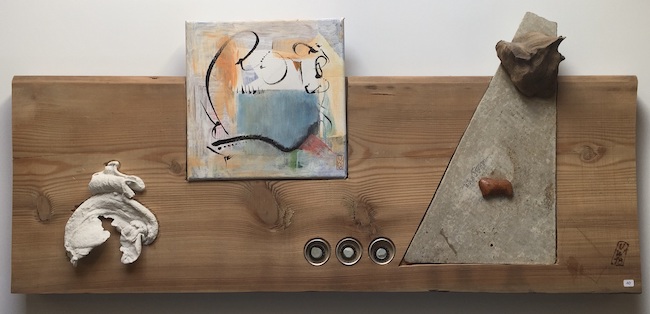Il percorso di molti artisti contemporanei presenta un’impronta decisamente aperta alla sperimentazione e alla contaminazione tra diversi stili che nel passato erano spesso nettamente divisi, se non addirittura in contrapposizione; la parola d’ordine dell’arte del ventunesimo secolo è invece la libertà di scegliere e di mescolare approcci e linguaggi per creare qualcosa di individuale che abbia una traccia più affine alle singole caratteristiche dell’esecutore dell’opera. L’artista di cui vi parlerò oggi ha compiuto un lungo cammino di sperimentazione per giungere al suo stile attuale.
Quando a metà degli anni Cinquanta del Novecento un gruppo di artisti avvertì l’esigenza di affermare con forza la necessità del recupero dell’emozione come base imprescindibile di un’opera d’arte, entrando dunque in antitesi con tutti movimenti precedenti che invece tendevano a dare priorità al concetto e al gesto plastico privato di ogni soggettività, il sistema dell’arte sembrò non essere pronto ad accogliere quell’innovazione al punto di rifiutare la presenza della nuova corrente in una grande mostra organizzata per presentare il panorama della creazione artistica dell’epoca. Il movimento in questione era l’Espressionismo Astratto e il rifiuto a inserirlo nella mostra venne da parte del Metropolitan Museum of Art di New York; la poca lungimiranza degli esperti del museo e la determinazione del gruppo ad affermare la loro nuova concezione decretarono il successo della corrente pittorica e la fecero di fatto conoscere al mondo. La necessità di imprimere istintivamente nelle tele l’impeto emotivo e le sensazioni più intime si manifestò attraverso una forte impronta personale poiché per ciascuno di essi era fondamentale mantenere il proprio individualismo, la libertà di lasciar fluire il loro sentire nella modalità più affine alla singola inclinazione. In Europa invece si andava affermando un movimento in cui, pur restando essenziale la manifestazione emotiva intima e personale, veniva introdotta la necessità della materia, degli oggetti di uso comune nelle tele sulle quali perciò lo stesso pathos espressivo si accentuava attraverso la solidità di quegli elementi tridimensionali essenziali per comunicare la forza di un mondo interiore e delle tempeste emozionali da cui si sentivano avvolti gli artisti che si avvicinarono all’Informale Materico. La capacità di Alberto Burri e di Antoni Tapìes di trasformare oggetti di uso comune, di agire su di essi modificandone la forma originaria adattandoli alla necessità narrativa, sono non solo testimonianza di quanto intenso fosse il messaggio che necessitavano esprimere malgrado una funzionale meditazione sul processo di mutamento dell’apparenza della materia che inserivano nella tela, ma anche anticipazione del concetto del riciclo che tanto appartiene alla sensibilità artistica contemporanea.
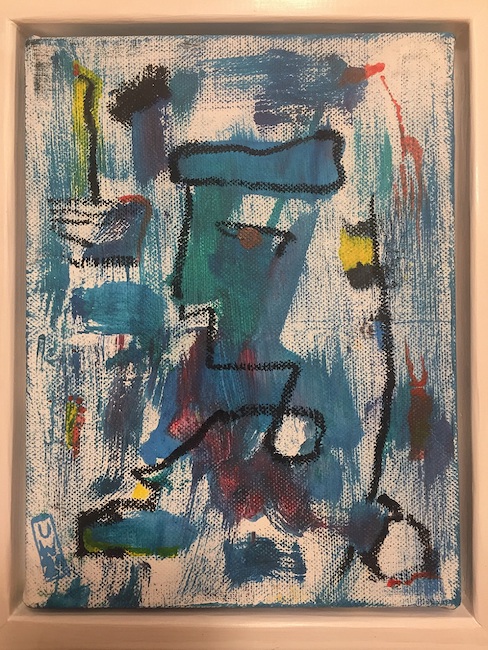
L’austriaco Ulrich Wallner approda a un linguaggio stilistico materico dopo anni di studio e di sperimentazione durante i quali ha appreso che la modalità più affine alla sua necessità espressiva era proprio quella della non forma, quell’universo costituito da emozioni narrate attraverso l’intensità e l’accostamento dei colori e che proprio in virtù della libertà dalla figurazione trova il suo fulcro comunicativo, pur mantenendo un lieve contatto con la delineazione della realtà attraverso un disegno spesso celato; il suo percorso accademico e di approfondimento della pittura inizia fin da ragazzo, inizialmente incentrato sul disegno e su stili più figurativi, in particolar modo era affascinato da Egon Schiele, Salvador Dalì e Henri de Toulouse-Lautrec, poi però si distacca in maniera via via più evidente dall’approccio naturalistico o ritrattistico orientandosi verso l’Espressionismo Astratto.
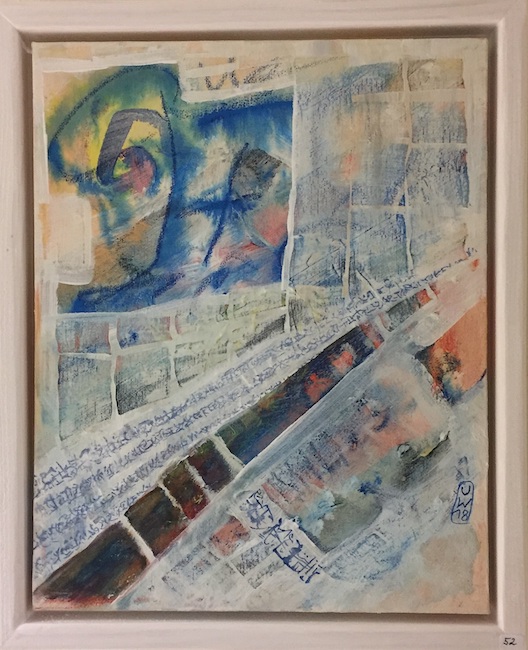
Tuttavia la sua innata curiosità lo spingono successivamente ad approfondire la conoscenza dell’Informale Materico e del Dada, studi a seguito dei quali comincia a introdurre materiali di recupero e oggetti che mescolano l’impeto creativo dell’Espressionismo Astratto a un rallentamento meditato e riflessivo dell’Informale Materico funzionale a inserire, trasformare, assemblare tutto ciò che colpisce la sua creatività al punto di desiderare di renderlo protagonista delle tele. La parte più istintiva si coniuga così a quella razionale donando alle sue opere il fascino enigmatico del concetto da scoprire, da estrapolare da un’immagine che si solidifica e si concretizza proprio in virtù dei collage, degli elementi apposti e inseriti nella tela oppure, in alcuni casi, costituenti l’opera che diviene di fatto una pittoscultura.
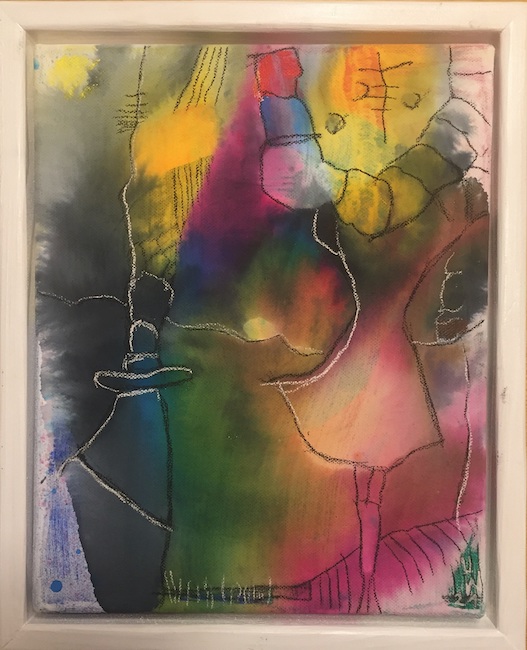
Gioca con le sensazioni Ulrich Wallner, come nella tela Ballerina in cui riesce a descrivere la leggerezza e la leggiadria della danzatrice pur non rappresentandola visivamente bensì tratteggiandone i contorni attraverso il disegno e poi lasciando alle tonalità scelte il compito di definirne l’essenza; i rosa intensi e i gialli ne raccontano la gioia e l’intensità emozionale tanto quanto i verdi e i grigi rappresentano la realtà intorno a lei, quella dimensione terrena e realista che viene illuminata dalla positività di una passione, di una dedizione a qualcosa in grado di elevare lo spirito e l’animo.
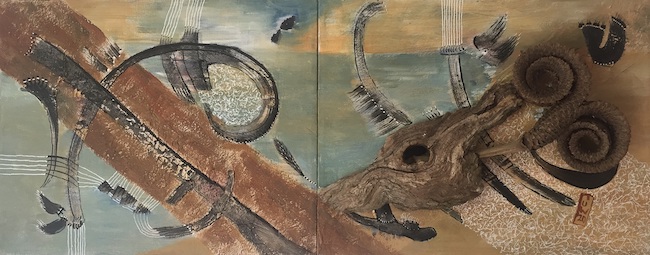
In Schwarze Wolken am Horizont (Nuvole nere all’orizzonte) Wallner tende a evidenziare la cupezza di un evento atmosferico inevitabile eppure in grado di modificare l’aspetto di tutto ciò che esiste, di cambiare gli umori e lo sguardo sulla realtà, almeno finché non passa oltre per lasciare di nuovo posto alla luce del sole; sembra un paesaggio a metà tra terra e mare quello raffigurato dall’artista, un luogo in cui evidenziare semplicemente il senso di impotenza davanti a un accadimento naturale da parte dell’uomo che non può che prenderne atto e attenderne il passaggio. In questa tela l’elemento materico è costituito da un frammento di tronco d’albero attraverso il quale l’artista sembra voler sottolineare quanto in fondo l’essere umano e la natura non possono che adeguarsi e restare stoici di fronte alla forza e all’ineluttabilità delle circostanze esterne e semmai cercare un modo per oltrepassare il momento di difficoltà.
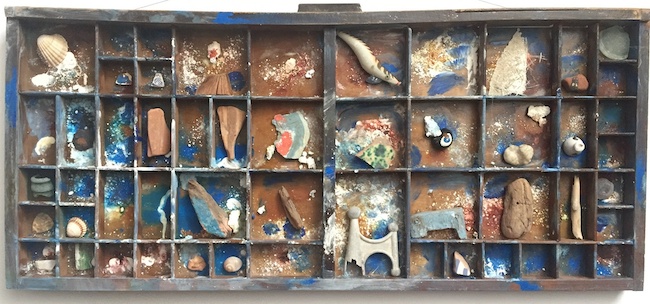
Il lavoro Maritime Erinnerung (Memorie marittima) appartiene invece a quel ciclo di pittosculture in cui l’opera è completamente costituita da elementi materici e lo sfondo espressionista astratto, rappresentante il mare e la sabbia, resta in secondo piano rispetto agli elementi che compongono l’immagine finale del puzzle dei ricordi, quei sassi trovati per caso, le conchiglie e gli oggetti notati sul bagnasciuga e raccolti per portare via con sé un frammento di una vacanza, una gita, un momento di piacevolezza che Ulrich Wallner non può fare a meno di immortalare.
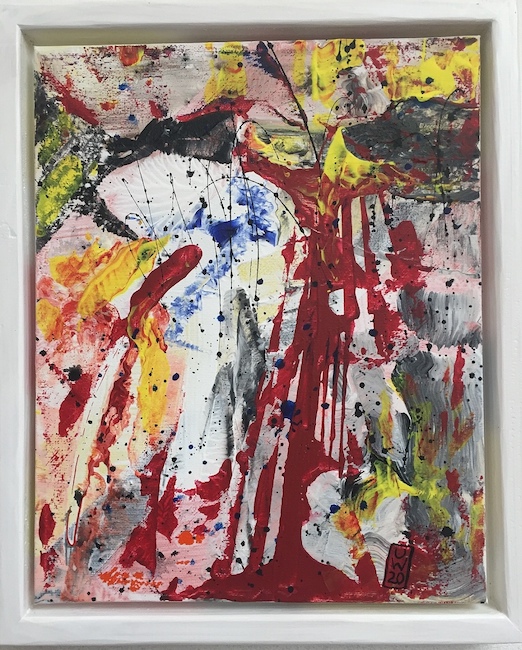
Gli oggetti diventano protagonisti tanto quanto le sensazioni lo sono nelle opere più legate all’Espressionismo Astratto, generando un’altalena stilistica in cui a volte è necessario che prevalga l’impeto emotivo e altre invece la spinta riflessiva che induce l’artista ad aggrapparsi alla concretezza di ciò che la sua esigenza razionale ritiene indispensabile per narrare una sensazione più intima, più consapevole e meditata; il suo desiderio è di stimolare l’osservatore a riflettere sulla temporaneità di tutto ciò che fa parte della quotidianità e che viene semplicemente gettato non appena smette di rivestire interesse o di essere utile. È quello il punto in cui interviene l’artista, recuperando ciò che altrimenti terminerebbe il suo ciclo di esistenza e dandogli nuova vita; recentemente ha iniziato a lavorare con prodotti di scarto della plastica che elabora e combina con altri materiali, dando così il suo contributo al tema dell’inquinamento ambientale e all’importante filosofia del riciclo.
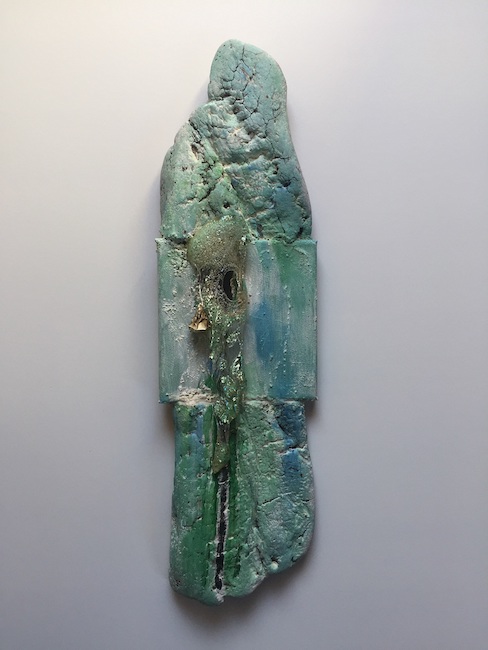
Negli ultimi anni Ulrich Wallner si è avvicinato alla scultura di cui lo affascina l’opportunità di plasmare e modellare la materia, mantenendo sempre la sua forte impronta astrattista. Espone regolarmente le sue opere in Austria, in particolare a Graz e a Donnersbach.
ULRICH WALLNER-CONTATTI
Email: ulwa1112@gmail.com
Facebook: https://www.facebook.com/ulrich.wallner
Matter meets expression in Ulrich Wallner’s solid artworks
The path of many contemporary artists is decidedly open to experimentation and contamination between different styles that in the past were often clearly divided, if not actually in opposition; the watchword of Twenty First century art is instead the freedom to choose and to mix approaches and languages in order to create something individual that has a trace more akin to the individual characteristics of the artwork’s creator. The artist I am going to talk about today has come a long way in experimentation to arrive at his current style.
When, in the mid-1950s, a group of artists felt the need to strongly affirm the recovery of emotion as the essential basis of an artwork, thus entering into antithesis with all previous movements that tended to give priority to the concept and the plastic gesture deprived of any subjectivity, the art system seemed not to be ready to accept this innovation to the point of refusing the presence of the new current in a major exhibition organised to present the panorama of artistic creation of the time. The movement in question was Abstract Expressionism, and the Metropolitan Museum of Art in New York refused to include it in the exhibition. The short-sightedness of the museum’s experts and the group’s determination to assert their new conception decreed the success of the pictorial current and made it known to the world. The need to instinctively imprint their emotional impetus and most intimate feelings on their canvases was manifested through a strong personal imprint, since for each of them it was fundamental to maintain their individualism, the freedom to let their feelings flow in the manner most suited to their individual inclinations.
In Europe, on the other hand, was gaining ground a movement in which, although the intimate and personal emotional manifestation remained essential, was introduced the need for substance, for everyday objects in canvases on which the same expressive pathos was accentuated through the solidity of those three-dimensional elements that were essential for communicating the strength of an inner world and the emotional storms by which the artists who approached the Material Informal felt enveloped. The ability of Alberto Burri and Antoni Tapìes to transform everyday objects, to act on them by modifying their original form and adapting them to narrative needs, is not only evidence of how intense was the message they needed to express despite a functional meditation on the process of changing the appearance of the material they inserted into the canvas, but also an anticipation of the concept of recycling that belongs so much to contemporary artistic sensitivity.
The Austrian artist Ulrich Wallner came to a materic stylistic language after years of study and experimentation during which he learned that the mode most akin to his expressive needs was precisely that of non-form, that universe made up of emotions narrated through the intensity and combination of colours and which, precisely by virtue of its freedom from figuration, finds its communicative fulcrum, while maintaining a slight contact with the delineation of reality through an often concealed drawing.a His academic career and in-depth study of painting began when he was a boy, initially focusing on drawing and more figurative styles, in particular Egon Schiele, Salvador Dalì and Henri de Toulouse-Lautrec, but he gradually moved away from the naturalistic or portrait approach and towards Abstract Expressionism. However, his innate curiosity later led him to deepen his knowledge of Material Informalism and Dada, studies after which he began to introduce recycled materials and objects that mixed the creative impetus of Abstract Expressionism with a meditated and reflective slowdown of Material Informalism, which was functional to insert, transform and assemble everything that struck his creativity to the point of wanting to make it the protagonist of his canvases.
The more instinctive side thus combines with the rational one, giving his artworks the enigmatic charm of the concept to be discovered, to be extrapolated from an image that solidifies and becomes concrete precisely by virtue of the collages, the elements affixed and inserted in the canvas or, in some cases, constituting the work, which in fact becomes a pictosculpture. Ulrich Wallner plays with sensations, as in the painting Ballerina in which he succeeds in describing the lightness and gracefulness of the dancer while not representing her visually but sketching her outlines and then leaving the chosen colours the task of defining her essence; the intense pinks and yellows convey her joy and emotional intensity just as much as the greens and greys represent the reality around her, that earthly, realistic dimension that is illuminated by the positivity of a passion, of a dedication to something capable of elevating the spirit and the soul. In Schwarze Wolken am Horizont (Black Clouds on the Horizon) Wallner tends to emphasise the gloom of an atmospheric event that is inevitable yet capable of modifying the appearance of everything that exists, of changing moods and the way we look at reality, at least until it passes over to make way for sunlight once again; the landscape depicted by the artist seems to be halfway between land and sea, a place in which to simply emphasise the sense of impotence before a natural event on the part of man, who can only take note of it and wait for it to pass. In this canvas, the material element consists of a fragment of a tree trunk, through which the artist seems to want to underline the extent how much, in the end, human beings and nature can only adapt and remain stoic in the face of the force and inevitability of external circumstances and, if anything, seek a way to overcome the moment of difficulty.
The work Maritime Erinnerung (Maritime Memories), on the other hand, belongs to that cycle of pictosculptures in which the artwork is completely made up of material elements and the abstract expressionist background, representing the sea and the sand, remains in the foreground compared to the elements that make up the final image of the puzzle of memories, those stones found by chance, shells and objects noticed on the shore and collected to take away with them a fragment of a holiday, an excursion, a moment of pleasure that Ulrich Wallner cannot help but immortalise. The objects become protagonists just as much as the sensations are in the works more closely linked to Abstract Expressionism, generating a stylistic seesaw in which at times the emotional impetus must prevail and at others the reflective thrust that induces the artist to cling to the concreteness of what his rational needs consider indispensable in order to narrate a more intimate, more conscious and meditated sensation; his desire is to stimulate the observer to reflect on the temporariness of everything that is part of everyday life and that is simply thrown away as soon as it ceases to be of interest or useful. This is the point at which the artist intervenes, recovering what would otherwise end its cycle of existence and giving it a new life; he has recently started working with plastic waste products which he processes and combines with other materials, thus making his contribution to the issue of environmental pollution and the important philosophy of recycling. In recent years Ulrich Wallner has turned to sculpture, in which he is fascinated by the opportunity to shape and mould the material, while still retaining his strong abstract style. He regularly exhibits his works in Austria, particularly in Graz and Donnersbach.
ULRICH WALLNER-CONTACTS
Email: ulwa1112@gmail.com
Facebook: https://www.facebook.com/ulrich.wallner


